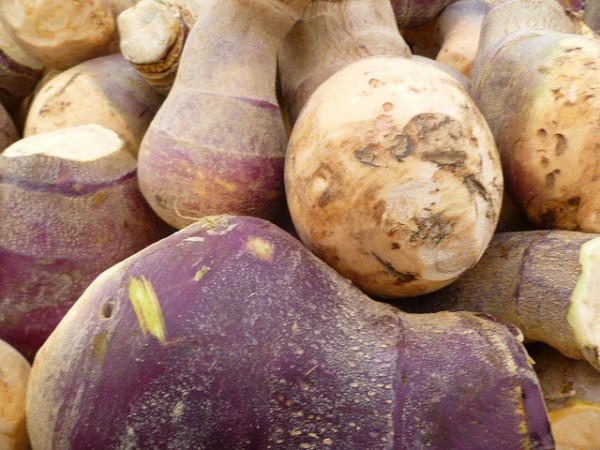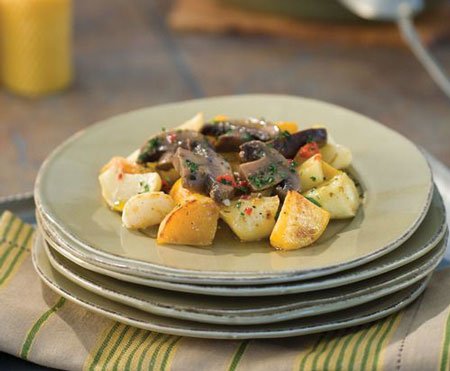How many of you have eaten rutabaga? C’mon, raise your hands. “I have! I have!”
I didn’t even realize I’d eaten one until the other day. I was doing research for this post and asked my husband if he’d ever tried one. He said yes and so have you. What? I have? When?
“A few weeks ago,” he answered. “They’re always available in the supermarket and they’re not expensive, so I bought one.”
He said he peeled it and chopped it into cubes. Then he boiled and mashed them like he would squash or turnips or potatoes. I never knew. I’ll pay more attention next time or maybe I’ll surprise him and make something different. Like the rutabaga recipe at the end of this post.
I’m told that rutabagas taste something like turnips. They also look something like turnips. They’re not turnips. “Rutabagas (often mistaken for overgrown turnips) are actually cruciferous vegetables — in the same group as cabbage and cauliflower,” says registered dietitian Kitty Broihier.
As you probably already know, cruciferous vegetables are
- rich in nutrients, including several carotenoids (beta-carotene and lutein, for example)
- rich in vitamins C, E, and K
- rich in folate
- rich in minerals
- a good source of fiber
Rutabagas are also
- fat free
- cholesterol free
- low in sodium
I dug a little deeper (pun not really intended) to find out the origins of rutabagas. They are a cross between turnips and Brassica oleracea which as Kitty said, includes cabbage and cauliflower.
In our neck of the woods, rutabaga is rutabaga but some people call them swedes or Swedish turnips or yellow turnips. And I read on Wikipedia that in parts of England they’re called snadgers or narkies.
Think you’d like to try one of those rutabagas or snadgers or swedes or whatever you call them? Fruits & Veggies More Matters has some helpful tips for you.
How to select
- Choose rutabagas that are heavy for their size and free of soft spots or cracks.
How to store
- Refrigerate rutabagas in a plastic bag for up to three weeks.
A rutabaga recipe
And now, let’s eat. I found this recipe on Oldways. The original version and the photo are courtesy of FOODMatch.
Portobello with Roasted Winter Root Vegetables (including rutabagas)
Author: FOODMatch and Oldways
6 servings
Paired with winter vegetable all-stars – parsnips, turnips, and rutabagas – portobello mushrooms add a meaty, warming quality. Using jarred mushrooms and peppers simplifies the recipe without sacrificing delicious Mediterranean flavors.
Ingredients
1 cup jarred portobello mushrooms with roasted peppers (reserve 1-2 tablespoons of marinade)
1 pound parsnips, peeled and cut into 1 1/2-inch pieces
1 pound turnips, peeled and cut into 1 1/2-inch pieces
1 pound rutabagas, peeled and cut into 1-inch pieces
4 tablespoons extra-virgin olive oil, divided
1 teaspoon fine sea salt
2 teaspoons cider vinegar
1 tablespoon fresh parsley, coarsely chopped
Instructions
1. Preheat oven to 400°F.
2. In a large bowl, toss the chopped vegetables with 2 tablespoons of the olive oil and salt. Roast them on a foil-lined baking sheet until lightly browned and tender, about 35 to 40 minutes, turning from time to time.
3. When they are ready, gently toss the cooked vegetables with the cider vinegar. 4. Transfer them to a serving platter and arrange the jarred mushrooms on top. Drizzle with the reserved marinade and remaining olive oil, and season with a pinch of salt and a sprinkle of parsley.
Calories: 190 Fat: 10g Saturated fat: 1g Carbohydrates: 26g Sodium: 640mg Protein: 3g
If you discover you love rutabagas and you can’t get enough of them, you might want to look into the 19th annual International Rutabaga Curling Championship in Ithaca, NY. Date TBA. It’s for real. This a Facebook picture from the 2013 curl. I wonder what happens to them after the event. Rutabaga stew?





Leave A Comment